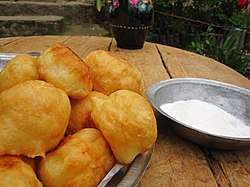Zalabiyeh
Zalabiyeh (Arabic: زلابية) is a fritter made from a semi-thin batter of wheat flour which is deep-fried and often topped with either honey or sugar syrup for sweetness. When kneading the dough, it is customary to give to the zalabiyeh a round shape, similar to the Moroccan sfenj in preparation, or to the English doughnut, but without the hole.
 Deep-fried zalabiyeh | |
| Alternative names | fritter; spongy-cake |
|---|---|
| Type | Fried dough |
| Region or state | Near East, Yemen, North Africa, Egypt, Israel |
| Main ingredients | Dough (flour, yeast, water, salt. Optional: eggs, milk, sesame oil, sesame seeds[1]) |
The fritter is very common in the Indian subcontinent, in countries such as India, Pakistan, Sri Lanka, Nepal, Bangladesh, although made differently to that of the Middle Eastern variety. In many Middle Eastern countries, such as Iran, Iraq, Jordan, Syria, Lebanon, Tunisia, Algeria, Egypt and also in Israel, they resemble spongy-cakes fried in oil.
Zalabiyeh are commonly eaten by Muslims during the month of Ramadan, and during the Diwali celebrations for Hindus and Christian communities during Advent and Easter. Among Yemenite Jews, the zalabiyeh was a treat eaten especially during the winter months.[2] In Yemen, the zalabiyeh was fried in a soapstone pot lined with oil about 1 cm. deep, in which oil and sometimes honey was mixed.[3]
Origin
Zalabiyeh as a fried-dough dates back to the 2nd millennium BCE, when King David's daughter prepared fritters (Hebrew: לְבִיבוֹת) for her step-brother Amnon, based on 2 Samuel 13:8-10.[4][3] By the 2nd-century CE, the name of the fritter had taken on the name sūfğenīn (Hebrew: סוּפְגְּנִין) in Mishnaic Hebrew, a word derived from its sponge-like texture with alveolar holes.[5][6][7]
In Iran, where it is known as zolbiya, the sweet was traditionally given to the poor during Ramadan. A 10th century cookbook gives several recipes for zalabiyeh. There are several 13th century recipes of the sweet, the most accepted being mentioned in a cookbook by Muhammad bin Hasan al-Baghdadi.[8] It was also mentioned in a tenth century Arabic cookbook by Ibn Sayyar al-Warraq, that was later translated by Nawal Nasrallah.[9][10]
In Iraq in the 20th-century, starch (Arabic: النشا) was a basic ingredient in their zalabiyeh, topped with sugar.[11] In North Africa, zalabiyeh was often made with yoghurt added to the dry ingredients.
See also
References
- Brauer, E. (1934). Ethnologie der jemenitischen Juden (Ethnology of Yemenite Jews) (in German). Heidelberg: Carl Winters Universitätsbuchhandlung. p. 100. OCLC 299777900.
- Mizrachi, Avshalom (2018), "The Yemenite Cuisine", in Rachel Yedid; Danny Bar-Maoz (eds.), Ascending the Palm Tree: An Anthology of the Yemenite Jewish Heritage, Rehovot: E'ele BeTamar, p. 132, OCLC 1041776317
- Qafih, Y. (1982). Halichot Teman (Jewish Life in Sanà) (in Hebrew). Jerusalem: Ben-Zvi Institute. p. 209. ISBN 965-17-0137-4. OCLC 863513860.
- Cf. David Kimhi, Commentary on 2 Samuel 13:8, who wrote: "...according to our Sages, of blessed memory, she made for him varieties of fried pastry, which is when they fry the dough in a frying pan containing oil." This same opinion is held by Levi ben Gershon, ibid, and by Rashi (ibid.) who adds that the fine flour used to make the dough was first scalded in hot water before being fried in oil.
- Nathan ben Abraham (1955), "Perush Shishah Sidrei Mishnah - A Commentary on the Six Orders of the Mishnah", in Sachs, Mordecai Yehudah Leib (ed.), The Six Orders of the Mishnah: with the Commentaries of the Rishonim (in Hebrew), 1, Jerusalem: El ha-Meqorot, OCLC 233403923, s.v. Hallah 1:5 (sūfğenīn, al-zalābiye)
- Hai Gaon (1921), "Hai Gaon's Commentary on Seder Taharot", in Epstein, J.N. (ed.), The Geonic Commentary on Seder Taharot - Attributed to Rabbi Hai Gaon (in Hebrew), 1, Berlin: Itzkowski, OCLC 13977130 (Available online, at HebrewBooks.org: The Geonic Commentary on Seder Taharot - vol. 1), s.v. Keilim 5:1 (p. 15)
- Cf. Mishnah (Hallah 1:5 (p. 83))
- Alan Davidson (21 August 2014). The Oxford Companion to Food. Oxford University Press. pp. 424–425. ISBN 978-0-19-967733-7.
- al-Warraq, Ibn Sayyar; Nasrallah, Nawal (Nov 26, 2007). annals of the caliphs' kitchens. BRILL. p. 413 chapter 100.
- al-warraq, ibn sayyar. "كتاب الطبيخ؛ وإصلاح الأغذية المأكولات وطيبات الأطعمة المصنوعات مما استخرج من كتب الطب وألفاظ الطهاة وأهل اللب". goodreads. Retrieved 17 September 2018.
- Yosef Hayyim (1986). Sefer Ben Ish Hai (Halachot) (in Hebrew). Jerusalem: Mercaz ha-sefer. p. 218 (First Year). OCLC 64088621.